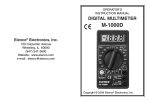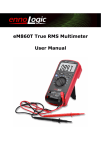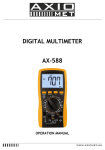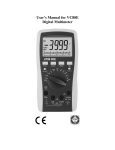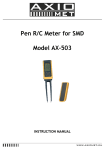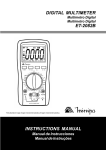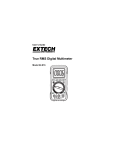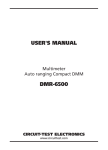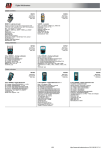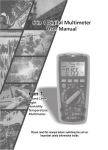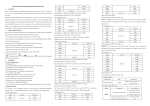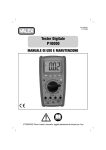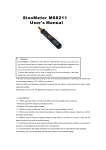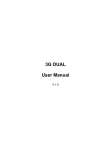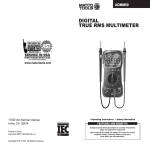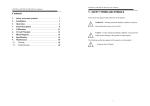Download DIGITALMULTIMETER
Transcript
DIGITALMULTIMETER USER’S MANUAL C C CONTENTS 1. GENERAL INSTRUCTIONS…………………………… 1 2. DESCRIPTION ………………………………………… . 4 3. TECHNICAL SPECIFICATIONS ………………………. 7 4. OPERATING INSTRUCTION …………………………..13 5. MAINTENANCE ………………………………………….18 1. GENERAL INSTRUCTIONS This multimeter has been designed according to IEC1010 concerning electronic measuring instruments with an overvoltage category (CAT II 1000V, CAT III 600V) and pollution 2. To get the best service from this instrument, read carefully this user's manual and respect the detailed safety precautions. 1.1 Precautions safety measures 1.1.1 Preliminary * When using this Multimeter, the user must observe all normal safety rules concerning: ― protection against the dangers of electric current. ― protection of the Multimeter against misuse. * For your own safety, only use the test probes supplied with the instrument. Before use, check that they are in good condition. 1.1.2 During use * If the meter is used near noise generating equipment, be aware that display may become unstable or indicate large errors. * Do not use the meter or test leads if they look damaged. * Use the meter only as specified in this manual; otherwise, the protection provided by the meter may be impaired. * Use extreme caution when working around bare conductors or bus bars. * Do not operate the meter around explosive gas, vapor, or dust. * Check the main function dial and make sure it is at the correct position before each measurement. * When the range of the value to be measured is unknown, check that the range initially set on the multimeter is the highest position. * To avoid damages to the instrument, do not exceed the maximum limits of the input values. * Caution when working with voltages above 60Vdc or 30Vac rms. Such voltages pose a shock hazard. * When using the probes, keep your fingers behind the finger guards. * Before changing functions, disconnect the test leads from the circuit under test. * Disconnect circuits power and discharge all high-voltage capacitors before testing resistance, continuity or diode. * Before attempting to insert transistors for testing, always be sure that test leads have been disconnected from any measurement circuits. * Components should not be connected to the hFE socket when making voltage measurements with test leads. * Before measuring current, turn off power to the circuit before connecting the meter to the circuit. * Change the battery when the symbol appears to avoid incorrect data. 1.1.3 Symbols: Symbols used in this manual and on the instrument: Caution: refer to the instruction manual. Incorrect use may result in damage to the device or its components. Earth This instrument has double insulation. Fuse: F 500mA/250V 1.1.4 Instructions * Before opening up the instrument, always disconnect from all sources of electric current and make sure you are not charged with static electricity, which may destroy internal components. * Any adjustment, maintenance or repair work carried out on the meter while it is live should be carried out only by appropriately qualified personnel, after having taken into account the instructions in this present manual. * If any faults or abnormalities are observed, take the instrument out of service and ensure that it can not be used until it has been checked out. * If the meter is not going to be used for a long time, take out the battery and do not store the meter in high temperature or high humidity environment. * For continue protection against fire, replace fuse only with the specified voltage and current rating: F500mA/250V. * Never use the meter unless the back cover and battery cover are in place and fastened fully. 2. DESCRIPTION 2.1 Instrument Familiarization 1 EF-DETECT Area 2 LCD display 3 Keypad 4 Back light key C 5 Rotary switch C 6 Terminals 2.2 LCD Display 3 3/4 digit, 18 mm high LCD. 2.3 ON/OFF key ¥ This key is used to turn the meter on or off 2.4 FUNC. key ¥ Selection of the dc (default) or ac mode and the (default) or mode: press on the key, the beep sounds briefly. ¥ This key is operative in A and ( ) ranges. 2.5 RANGE key ¥ Selection of the automatic (default) or manual mode: short press < 1 sec. on the key, the beep sounds briefly. ¥ Switch from manual to autoranging mode: long press > 1 sec. on the key, the beep sounds briefly. ¥ In manual mode, ranges selection: press successively < 1 sec. on the key. ¥ This key is operative in V and Ω ranges. 2.6 HOLD key ¥ Fixes the display on the current value and memories it (short press). ¥ A second short press returns the meter to normal mode. 2.7 REL key ¥ Selection of the Relative measurement mode, press on the key, the beep sounds briefly. ¥ This key is operative in V, A, Ω and CAP ranges. 2.8 Back light key ¥ This key is used to turn the back light on or off. Press the key >2 sec. the backlight will be turned on. Press the key again , the backlight will be turned off. ¥ the key is’t operative in range. 2.9 Rotary switch This switch is used to select functions and desired ranges . There are different functions and 11 ranges provided. 2.10 Terminals ¥ VΩ ΩHz℃ ℃ : Terminal receiving the red lead for voltage, resistance, capacitance, temperature, frequency, diode and continuity measurements. ¥ COM:Terminal receiving the black lead as a common reference. ¥ uAmA : Terminal receiving the red lead for uAmA measurement.. ¥ 10A : Terminal receiving the red lead for 10A measurement. 3. TECHNICAL SPECIFICATIONS 3.1 General specifications ¥ Environment conditions: 600V CAT.III and 1000V CAT.Ⅱ Pollution degree: 2 Altitude < 2000 m Operating temperature: 0~40 OC, (<80% RH, non-condensing) Storage temperature: -10~60 OC, (<70% RH, battery removed) ¥ Temperature Coefficient: 0.1×(specified accuracy) / OC (<18 OC or >28 OC) ¥ MAX. Voltage between terminals and earth ground: 750V AC rms or 1000V DC ¥ Fuse Protection: uAmA: F 500mA/250V ∅5×20 ¥ Sample Rate: 3 times/sec for digital data. ¥ Display: 3 3/4 digits LCD display with max. reading 3999, Automatic indication of functions and symbols. ¥ Range selection: automatic and manual. ¥ Over Range indication: LCD will display "OL". ¥ Low battery indication: The " " is displayed when the battery is under the proper operation range. ¥ Polarity indication: "−" displayed automatically. ¥ Auto power off: If there is no key or dial operation for 15 minutes, the meter will power itself off to save battery consumption. One minute before power off, the beeper will sound 5 sounds. The beeper will sound again before power off. ¥ Power source: 4.5V battery ¥ Dimensions: 156(L)×82(W)×29(H) mm. ¥ Weight: 220g. Approx. (battery included). ¥ Accessories: User's manual. Test leads. Carry case. “K” type thermocouple 3.2 Measurement specifications * Accuracy: ±(% of reading + number of digits) at 18OC to 28OC (64OF to 82OF) with relative humidity to 80%. 3.2.1 No contact AC Voltage detector Sensitivity Frequency distance >50V 50Hz < 150mm 3.2.2 DC Voltage Range Resolution Accuracy 400mV 0.1mV ±(0.8% of rdg +3 digits) 4V 1mV 40V 10mV 400V 100mV 1000V 1V ±(1.0% of rdg +3 digits) Input impedance: 10MΩ Maximum input voltage: 1000V dc or 750V ac rms. 3.2.3 AC Voltage Range Resolution 4V 1mV 40V 10mV 400V 100mV Accuracy ±(1.0% of rdg +3 digits) 750V 1V ±(1.2% of rdg +3 digits) Input impedance: 10MΩ Maximum input voltage: 1000V dc or 750V ac rms. Frequency Range: 40Hz-400Hz, Response: Average, calibrated in rms of sine wave 3.2.4 DC Current Range Resolution Accuracy 4000uA 1µA 400mA 0.1mA ±(1.2% of rdg +3 digits) 10A 10mA ±(2.0% of rdg +8digits) Overload protection: F 500mA/250V fuse for uAmA range. Maximum input current: 400mA dc or 400mA ac rms for µA and mA ranges. 10A dc or 10A ac rms for 10A ranges. 3.2.5 AC Current Range Resolution Accuracy 4000uA 1µA 400mA 0.1mA ±(1.5% of rdg + 5 digits) 10A 10mA ±(3.0% of rdg + 8 digits) Overload protection: F 500mA/250V fuse for uAmA range. Maximum input current: 400mA dc or 400mA ac rms for µA and mA ranges. 10A dc or 10A ac rms for 10A ranges. Frequency Range: 40Hz-400Hz, Response: Average, calibrated in rms of sine wave 3.2.6 Resistance Range Resolution 400Ω 0.1Ω 4kΩ 1Ω 40kΩ 10Ω 400kΩ 100Ω 4MΩ 1kΩ 40MΩ 10kΩ Accuracy ±(1.2% of rdg +3digits) ±(2.0% of rdg +5 digits) Open circuit voltage: approx. 0.25V Overload protection: 250V dc or 250V ac rms. 3.2.7 Diode and Audible continuity Test Range description Test Condition Open circuit voltage: approximate 0.5V Built-in buzzer sounds if resistance is less than approx.40Ω Forward DC Current: approx. 1mA Reversed DC Voltage: approx. 1.5V Display read approx. forward voltage of diode Overload protection: 250V dc or 250V ac rms. 3.2.8 Temperature Range Resolution Accuracy -20℃ to 0℃ 1℃ ±(5% of rdg +4 digits) 0℃ to 400℃ 1℃ ±(1% of rdg +3 digits) 400℃ to 1000℃ 1℃ ±(2% of rdg +3 digits) Overload protection: 250V dc or 250V ac rms. 3.2.9 Capacitance Range Resolution Accuracy 4nF 1pF ±(5.0% of rdg +5 digits) 40nF 10pF ±(3.0% of rdg +5 digits) 400nF 100pF 4µF 1nF 40µF 10nF 200µF 100nF Overload protection: 250V dc or 250V ac rms.。 3.2.10 Frequency Range Resolution 9.999Hz 0.001 Hz 99.99Hz 0.01 Hz 999.9Hz 0.1 Hz 9.999kHz 1Hz 99.99kHz 10Hz 199.9kHz 100Hz Accuracy ±(0.1% of rdg +1 digit) >200kHz 100Hz Unspecified @ >200kHz Overload protection: 250V dc or 250V ac rms. Input Voltage range: 0.6V-3V ac rms (Input voltage must be enlarged with increasing frequency under measurement) 4. OPERATING INSTRUCTION 4.1 No contact AC Voltage detector There is no auto power off function. And the backlight is’t operative in this range. ¥ Set rotary switch to the range. Then the green LED of the LED indicator is bright. ¥ Put the EF-DETECT AREA close to the lead or the power socket , if AC electrical voltage is present , the red LED indicator which in the top of the meter will flash and the audible warning will sound,and the figure will be displayed on the LCD. 4.2 Voltage measurement To avoid electrical shock and/or damage to the instrument, do not attempt to take any voltage measurement that might exceeds 1000Vdc or 750Vac rms. Do not apply more than 1000Vdc or 750Vac rms between the common terminal and the earth ground. ¥ Set rotary switch to the V (ACV or DCV) range. ¥ Press "RANGE" key to select manual range ¥ Connect the black and red test leads to the COM and V terminals respectively ¥ Connect the test leads to the circuit being measured ¥ Read the displayed value. The polarity of red test lead connection will be indicated when making a DC measurement. 4.3 Resistance measurement To avoid electrical shock and/or damage to the instrument, disconnect circuit power and discharge all high-voltage capacitors before measuring resistance. ¥ Set the rotary switch to Ω range.。 ¥ Connect the black and red test leads to the COM and VΩ terminals respectively. ¥ Connect the test leads to the circuit being measured and read the displayed value. ¥ In order to ensure the best accuracy in measurement of low resistance, short the test leads before measurement and memory the test probe resistance in mind. This necessary to subtract for the resistance of the test leads. NOTE: ¥ For measuring resistance above 1MΩ, the meter may take a few seconds to stabilize reading. This is normal for high resistance measuring. ¥ When the input is not connected, i.e. at open circuit, the figure "OL" will be displayed for the overrange condition. 4.4 Continuity measurement To avoid electrical shock and/or damage to the instrument, disconnect circuit power and discharge all high-voltage capacitors before testing for Continuity.。 ¥ Set the rotary switch to ( ) range. ¥ Press "FUNC." key to select measuring mode. ¥Connect the black and red test leads to the COM and Ω terminals respectively. ¥ Connect the test leads to the resistance in the circuit being measured. ¥ When the test lead to the circuit is below 40Ω, a continuous beeping will indicate it. Note: continuity test is available to check open/short of the circuit. 4.5 Diode measurement To avoid electrical shock and/or damage to the instrument, disconnect circuit power and discharge all high-voltage capacitors before testing diodes. ¥ Set the rotary switch to ( ) range. ¥ Press "FUNC." key to select measuring mode. ¥ Connect the black and red test leads to the COM and Ω terminals respectively. ¥ Connect the red test lead to the anode, black test lead to the cathode of the diode under testing. ¥ The meter will show the approx. forward voltage of the diode. If the lead connection is reversed, only figure "OL" displayed. 4.6 Capacitance measurement To avoid electrical shock and/or damage to the instrument, disconnect circuit power and discharge all high-voltage capacitors before measuring capacitance. Use the dc voltage function to confirm that the capacitor is discharged. ¥ Set the rotary switch to range. ¥ Connect the black and red test leads to the COM and terminals respectively. ¥ Connect the test leads to the capacitor being measured and read the displayed value. NOTE: ¥ The meter may take a few seconds (200µF range, 30 seconds) to stabilize reading. This is normal for high capacitance measuring. ¥ To improve the accuracy of measurements less than 4nF, subtract the residual capacitance of the meter and leads. 4.7 Frequency measurement ¥ Set the rotary switch to Hz range. ¥ Connect the black and red test leads to the COM and Hz terminals respectively. ¥ Connect the test leads across the source or load under measurement, and read the displayed value. Note: ¥ Reading is possible at input voltages above 3V rms, but the accuracy is not guaranteed. ¥ In noisy environment, it is preferable to use shield cable for measuring small signal. 4.8 Temperature measurement To avoid electrical shock, do not connect the thermocouples with the electriferous circuit. ¥ Set the rotary switch to ℃ range. And the LCD display will show the current environment temperature. ¥ Connect the red lead of“K” type thermocouple into the ℃ jack and the black lead of“K”type thermocouple into the “COM” jack. ¥ Contacting the object be measured with the thermocouple probe. ¥ Read temperature value on the LCD display. 4.9 Current measurement To avoid damage to the meter, check the meter's fuse before proceeding. Use the proper terminals, function, and range for your measurement. ¥ Set the rotary switch to the 4000µA, 400mA or 10A range. ¥ Press "FUNC." key to select DCA or ACA measuring mode. ¥ Connect the black test lead to the COM terminal and the red test leads to the mA terminal for a maximum of 400mA. For a maximum of 10A, move the red test lead to the 10A terminal. ¥ Connect test leads in series with the load in which the current is to be measured. ¥ Read the displayed value. The polarity of red test lead connection will be indicated when making a DC measurement. ¥ When only the figure "OL" displayed (Buzzer will sound continually), it indicates overrange situation and the higher range has to be selected. 4.10 Misplug Alarm To avoid damage to the meter,the meter provide “Misplug Alarm” function. When the meter alarm , please check the range and the terminal of the lead. Following operation will bring alarm: ¥ Set the rotary switch to the any range expect A and range , Connect the test lead to the uAmA or 10A terminal, meter alarm. ¥ Set the rotary switch to the uA or mA range, Connect the test lead to the 10A terminal, meter alarm. ¥ Set the rotary switch to the 10A range, Connect the test lead to the uAmA terminal, meter alarm. 5. MAINTENANCE 5.1 General Maintenance To avoid electrical shock or damage to the meter, do not get water inside the case. Remove the test leads and any input signals before opening the case。 Periodically wipe the case with a damp cloth and mild detergent. Do not use abrasives or solvents. Dirt or moisture in the terminals can affect readings. To clean the terminals: ¥ Turn the meter off and remove all test leads. ¥ Shake out any dirt that may be in the terminals. ¥ Soak a new swab with a cleaning and oiling agent (such as WD-40). ¥ Work the swab around in each terminal. The oiling agent insulates the terminals from moisture-related contamination. 5.2 Fuse replacement Before replacing the fuse, disconnect test leads from any circuit under test. To prevent damage or injury, replace the fuse only with specified ratings. ¥ Set the meter to OFF state. ¥ Disconnect test leads from any inputs terminals. ¥ Use a screwdriver to unscrew the three screws secured on the back cover and the battery cover , then unscrew the two screws under the battery cover. ¥ Separate the back cover from the top case. ¥ Replace the fuse only with specified ratings: F 500mA/250V ∅5×20. ¥ Replace the back cover and secure by the screws. 5.3 Battery replacement Before replacing the battery, disconnect test leads from any circuit under test, turn the meter off and remove test leads from the input terminals. Use the following procedure: ¥ When the battery voltage drop below proper operation range the symbol will appear on the LCD display and the battery need to be replaced. ¥ Set the meter to OFF state. ¥ Disconnect test leads from any inputs terminals. ¥ Use a screwdriver to unscrew the two screws secured on the battery cover. ¥ Replace the battery with three new 1.5V batteries(AAA). ¥ Replace the battery cover by the two screws.






















